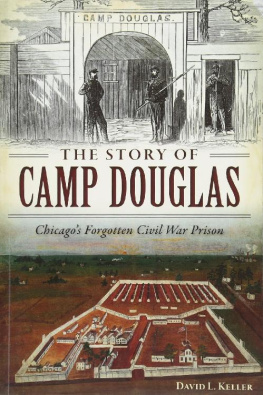
Published by The History Press
Charleston, SC 29403
www.historypress.net
Copyright 2015 by David Keller
All rights reserved
First published 2015
e-book edition 2015
Cover images courtesy of the Chicago History Museum.
ISBN 978.1.62585.444.5
Library of Congress Control Number: 2014958795
print edition ISBN 978.1.62619.911.8
Notice: The information in this book is true and complete to the best of our knowledge. It is offered without guarantee on the part of the author or The History Press. The author and The History Press disclaim all liability in connection with the use of this book.
All rights reserved. No part of this book may be reproduced or transmitted in any form whatsoever without prior written permission from the publisher except in the case of brief quotations embodied in critical articles and reviews.
In memory of seventy thousand Union and Confederate soldiers on whom Camp Douglas left a lasting mark.
Contents
Foreword
A few years ago, Dave Keller contacted me and asked a question that is not often heard: Do you have a ground-penetrating radar? Although unusual, I had heard it beforeand yes, I did have one. After all, being an archaeologist and military historian put me in a position to receive such a question. Before I knew it, Dave had come to Kenosha to tour the Civil War Museum. Soon we were plotting ground-penetrating radar work to further efforts to locate the remains of Camp Douglas, the Chicago Civil War training camp and later prison for Confederate soldiers. Daves enthusiasm for Camp Douglas was infectious. I was not a stranger to the subject, yet he told me things that I did not know about the camp. Not only was I intrigued; I was hooked.
When we think of the Upper Midwest and the Civil War, we think of far-off battlefields, not the agricultural products, meat, hides, clothing, shoes and other supplies that came out of the West. Sometimes we think of Lincoln or Grant, but we rarely think about the nearly 250,000 men whom Illinois alone sent into battle. The importance of the homefront, and the need for prison camps, do not come to mind either.
Before the 1990s, even professional historians gave these camps little thought. Since then, their documentation has sometimes been uneven. Some works have been accusatory or apologetic. It is a difficult and unpleasant subject, especially during a time when the condition of soldiers in the field in terms of food, sanitation and crowding was not much better.
In this work, Keller looks at a camp that carries a bad reputation as an Andersonville of the North. He looks beyond the facts and figures. He delves into the firsthand accounts provided by Confederate prisoners, Union officers, inspectors and others. Dissecting the often-dry official documents, he makes them interesting and relevant. He turns these varied sources into an investigation of Camp Douglas, bringing the camp to life subject by subject while also asking, Why? Here, the story inside the stockade is revealed. We are wise not to ignore the firsthand accounts of those who were there before the fort vanished from history in 1865 and became an archaeological site.
DAN JOYCE
Director
The Civil War Museum, Kenosha, Wisconsin
November 2014
Prefaces
David Keller shows conclusively that all history is now. The Story of Camp Douglas: Chicagos Forgotten Civil War Prison brings to life the realities of life and death during the Civil War (186165), Americas most deadly conflict. It is one of the finest community studies one will read, with Camp Douglas as the communitys center from 1862 to 1865. We meet Union and Confederate officers and soldiers as guards, prisoners and public enemies. We learn about the Chicago of that era and what modern Chicagoans are trying to do about it. In short, it is a marvelous book that has been expertly written and well researched by a knowledgeable and passionate author.
I first met David Keller when I gave a talk about my book The Enemy in Our Hands at the prestigious Pritzker Military Library in 2010. He told me about his project: the discovery of the lost remains of Camp Douglas, the largest Union prison camp in the North. I had visited several Union and Confederate prison camp sites during my own research, including Fort Delaware at the mouth of the Delaware River; Johnsons Island in northern Ohio; Camp Chase in Columbus, Ohio; and, of course, Andersonville in Georgia. But Camp Douglas was seemingly lost to historians forever. Not so. David Keller and his cast of loyal diggers and researchers are turning all this around in Chicagos South Side. This book shows just what has been achievedhistory has again come alive.
The strong relationship that existed between the people of Chicago and Camp Douglas during the Civil War is a vital link in the story of the camp. We meet passionate Unionists and Copperheads in head-to-head conflict, all linked to Confederate plans to liberate Camp Douglas, Johnsons Island and possibly other camps in order to create a huge Confederate army in the north. The plan failed, but the effort remains impressive.
Lastly, one of the most contentious issues concerning Civil War prison camps in both the North and South involves the hideous death rates suffered by both sides behind the wire. Did both sides create POW policies that ensured so many deaths? Did U.S. Grant realize that the Confederacy simply could not sustain its Union POW population with the resources at hand when he and Abraham Lincoln canceled the Dix-Hill Cartel, which worked so well from 1862 to 1863? Did both sides understand medicine well enough to prevent unnecessary death from war wounds and diseases? Why were the food and provisions so bad on both sides? Did General Order 100, promulgated in July 1863, change anything in the field or the prison pen? These and other questions are addressed in this fine work. Thus, I salute David Keller and everyone involved with this project. It is well worth the effort and a wonderful contribution to POW history in general and Civil War studies in particular.
ROBERT. C. DOYLE, PHD
October 2014

What might well be the largest mass grave in the United States can be found in a peaceful, garden-like cemetery on the south side of Chicago. Beneath a forty-foot-tall granite-and-bronze memorial gathered together in a grass-covered earthen mound are the bones of between 4,200 and 6,000 soldiers of the Confederate States of America. These soldiers did not die at Gettysburg in the desperate charge at the high tide of their cause, nor were they among the fallen at Shilohs harvest of death, after which it was said that the South never smiled. Rather, these soldiers died far from the scenes of battle in one of the largest cities in the United States at the Camp Douglas prisoner of war facility. More Southern soldiers died at the camp than on any Civil War battlefield. The purpose of this book is to explore how and why this happened and to examine the significance of the true story of Camp Douglas as it relates to our understanding of the Civil War.
The story of Camp Douglas has been alternately distorted and neglected. In the city of Chicago, the existence of the massive prison camp, as well as the citys important role in the Civil War, has been all but forgotten. Only recently, through the efforts of the Camp Douglas Restoration Foundation, has this Civil War site even been graced with a historical marker. While the history of the camp is little appreciated in Chicago, it is well known among Civil War scholars and enthusiasts. Since the era of Reconstruction in the wake of the war, Camp Douglas has played a role in the Lost Cause mythology that paints the Southern Confederacy in heroic hues and condemns the Union war effort as unnecessarily brutal. Eighty Acres of Hell or the Northern Andersonville are phrases used in this genre to describe Camp Douglas.
Next page











